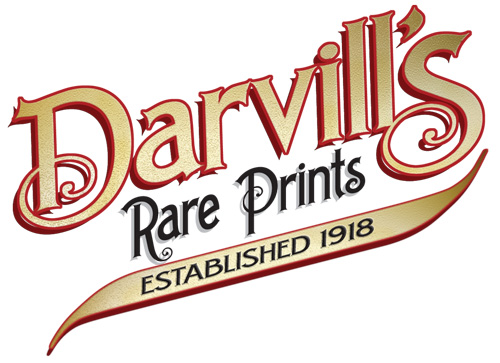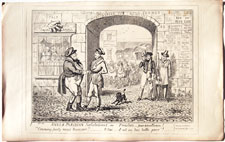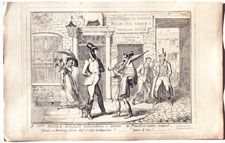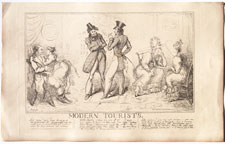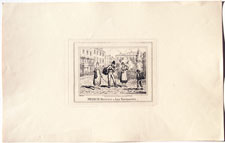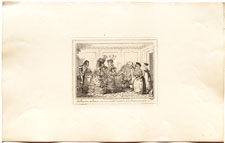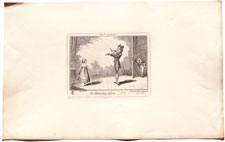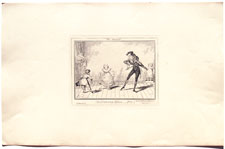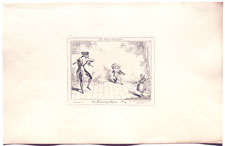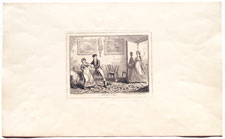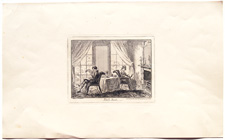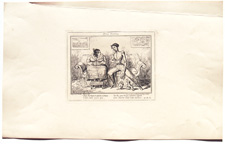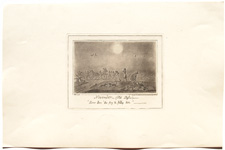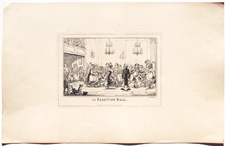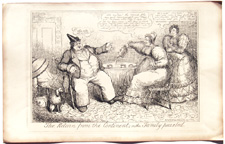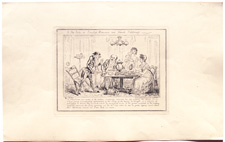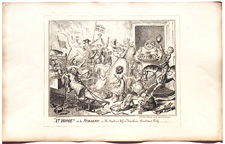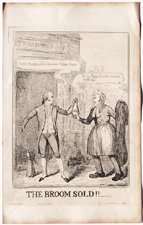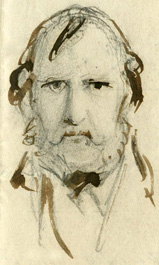
George Cruikshank
(self portrait)
Background of LIfe in London:
The Microcosm of London was dedicated to the prince of Wales, afterwards George IV. So, also, in the year after his accession to the throne, was a less august work, which still, in its way, reflects the interest in London and the interest in ordinary life, both of which had been fostered by the influence of caricature and the increasing popularity of illustrated books.
The book referred to was Pierce Egan’s Life in London; or, The Day and Night Scenes of Jerry Hawthorn, Esq. and his elegant friend Corinthian Tom, accompanied by Bob Logic, The Oxonian, in their Rambles and Sprees through the Metropolis, a work which was issued in and after July, 1821, in shilling numbers. Of Pierce Egan, the author of this work, more will be said in connection with books on sport. A journalist, and a well-known character in his day, he wrote nothing so popular as this Life in London. Indeed, the taste for it amounted to a craze.
For his illustrations, Egan went to two brothers, Isaac Robert and George Cruikshank, sons of a Scottish artist who had settled in London. George Cruikshank, the younger and abler brother, had already maintained the succession from Gillray and Rowlandson as a political caricaturist. His designs in The Scourge and The Meteor; his plates in William Combe’s “hudibrastic poem” The Life of Napoleon (1814–15); his coloured etchings in The Humourist, a collection of comic tales published in 1819–21, and his many caricatures of Napoleon, of the prince regent and his wife, of Frenchmen and of the excesses of English fashion, had laid the foundations of a fame which was greatly increased by his work for Life in London.
Each of the coloured plates is stated to be by I. R. and G. Cruikshank; but, later in his life, George Cruikshank, by then a reformed character and an ardent teetotaller, declared that his doubts about the morality of Egan’s work had caused him to leave two-thirds of the illustration to be done by his brother Robert. Be that as it may, the success of the work was so great that the artists could not colour the engravings fast enough for the demand. It suited the taste of the time, when a “fast” life had become a sophisticated and conscious aim.
Life in London is a guide to a fast life. Egan was a “sporting” man who did not sport. Except for a jejunely described run with hounds, a statement that Corinthian Tom had a set-to with John Jackson, the ex-champion pugilist of England, at his rooms in Bond street, and some praise from Tom’s friends for his “superior style” and “coolness and skill” in a fencingbout with O’shaunessy, there is not a word of true sport in the book. The remainder is mainly drinking, gambling, rioting, cock-fighting and other branches of debauchery, either practised or contemplated by the friends. It is significant that, of the three adventurers, the name of Corinthian Tom appears in the largest type upon the title-page. Tom, indeed, is the hero of the tale. He is the ideal “man about town”; and, however lavishly the author may praise his elegance and accomplishment, he remains the type of the polished blackguard, unworthy to associate with his country cousin, Jerry Hawthorn, the cheery fool to whom he shows “the pleasures of the town,” and only a shade more intolerable than the bestial creature, Bob Logic, who is intended for a model of good-humour and wit. In his first chapter, or “invocation,” Egan appeals to Fielding, Goldsmith, Smollett and Sterne (“Come, then,” he characteristically writes, “thou shades of departed talent”).
His book, with its leer and wink of knowing vice, its sickly affectation of warning young men from the haunts and pursuits that it lusciously describes, would have disgusted even Sterne in the moments when his physical weakness was most perverting his facile imagination. The candid rogues of great picaresque fiction would be ashamed to own Tom or Logic for their kin.
Thackeray, indulging in sentimental reminiscences in days when “the literary contents of the book” had “passed sheer away” from his memory, declared that, in the days when the work appeared, "...we firmly believed the three heroes above named to be types of the most elegant, fashionable young fellows the town afforded, and thought their occupations and amusements were those of all highbred English gentlemen."
Twenty years later, when he had read “the literary contents of the book” again, he said:
But the style of the writing, I own, was not pleasing to me; I even thought it a little vulgar … and as a description of the sports and amusements of London in the ancient times, more curious than amusing.
Thackeray, therefore, nowhere has a good word to say for anything about Life in London except the pictures. “More curious than amusing” is a just criticism. The work is curious, partly for the details that it furnishes of London life in a period when manners were very pompous or very vulgar; and partly for its wealth in the slang of the time. Egan was a master of the “flash” and the flashy; and Life in London contains as many slang phrases as he could put into it. Two years later, he was to furnish the slang phrases to Francis Grose’s Dictionary of the Vulgar Tongue (1823); and one of his two illustrators, George Cruikshank, had already drawn a plate for Andrewes’s Dictionary of the Slang and Cant Languages (1809).
Part of the success enjoyed by the work was due, no doubt, to its readers’ belief that they could name the originals of the fictitious characters. Imitations came swift and frequent. In the summer of 1822 plays founded upon the story were being acted at no less than ten theatres in and about London; and among the adapters were Charles Dibdin, whose version was played at the Olympic, and W. T. Moncrieff, whose play ran for more than 300 nights at the Adelphi theatre. It was Moncrieff who, in answer to the accusation that Egan and he had made their age the age of flash, replied in the wellknown but inconclusive saying, “Any age is better than the age of cant”—cant implying, of course, the protests of certain portions of the press and of some religious bodies. Egan himself produced, in 1822, a dramatic version of the story, which was played without success (save for a pony-race round the theatre) at Astley’s. The book was, also, translated into French. Out of the sixty-five imitations of it which Egan stated that he had reckoned, the most important was Real Life in London, or, the Rambles and Adventures of Bob Tallyho, Esq. and his cousin, the Hon. Tom Dashall, through the Metropolis; exhibiting a living picture of fashionable characters, manners, and amusements in high and low life, which was published in sixpenny numbers in 1821, with excellent illustrations by Heath, Alken, Dighton, Rowlandson and others. Real Life in London is a pleasanter book than its prototype. Some have held that Egan wrote it; but the author had a purer style, a cleaner mind and a wider knowledge of London than Egan. The book shows many more sides of London life than his; though the formal descriptions of wellknown scenes or buildings, here and there inserted amid matter of a very different character, recall very forcibly Mr. Bouncer’s letters to his aunt in Verdant Green. Another imitation was Life in Paris: The Rambles of Dick Wildfire (1821), written, it is suspected, by David Carey, and illustrated by George Cruikshank, who had never been to Paris, but was accustomed to drawing his own idea of French people in his caricatures, and took his scenes from the drawings and paintings of other artists.
[Source: catterall.net] |





